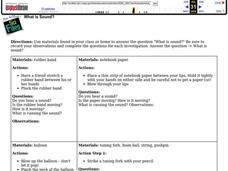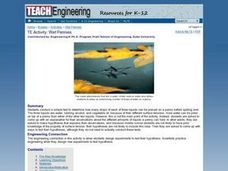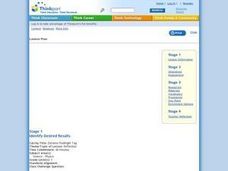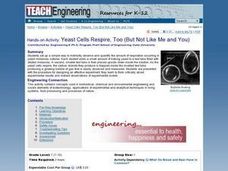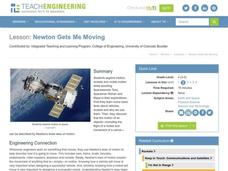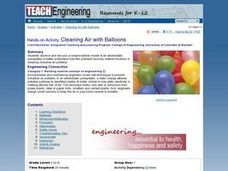Curated OER
What is Sound?
In this sound worksheet, students complete 4 investigations to explore sound. These include the use of a rubber band, a blown up balloon, a piece of notebook paper and a tuning fork with a foam ball, string and pushpin. Students answer...
Curated OER
Wet Pennies
Students conduct a simple test to determine how many drops of water, rubbing alcohol and vegetable oil can be placed on a penny before spilling over. They consider how varying surface tensions allow for different amounts of each liquid...
Curated OER
Extreme Flashlight Tag
Fifth graders view a Powerpoint show about reflecting light. They experiment through a reflection simulation on the internet. Students complete the activity by using mirrors and light to complete send light to a specified spot.
Curated OER
Red Light, Green Light
Students investigate the friction between tires and the road and how it affects the movement of cars while driving. They discuss and define friction, experiment with sandpaper and wax paper to determine which material provides the least...
Curated OER
What's Air Got to Do with It?
Students use M&M's to create a pie graph that expresses their understanding of the composition of air. They watch and conduct several simple experiments to develop an understanding of the properties of air (it has mass, it takes up...
Curated OER
To Float or Not to Float, That is the Question?
Ninth graders develop operational definition of density, do computations using density equation, categorize pieces of matter as being able to float on
water or not, based on density, explain why some objects sink or float based on...
Curated OER
Chances Are
Students are involved in activities that give them experiences predictingthe likelihood of certain events occurring. They become aware that certain outcomes are equally likely, more likely,or less likely than others to occur. Students...
Curated OER
Nature Superfish
Students examine the billfish as a predator in the ocean. In this ocean, creatures, and tides lesson, students view video clips and discuss the sea creatures and scientists in the videos. Students create their own videos. students...
Curated OER
Chocolate Asphalt Cookies
Students make no-bake cookies to learn basic engineering principles, road construction and material science. They experience properties and changes in matter.
Curated OER
Floodplain Modeling
Students simulate the impact of fluctuating river volumes on structures and landforms. They experiment with table top-sized riverbed models and water. Students consider how human design can help mitigate the effects of a flood.
Curated OER
Stop Heat from Escaping
Students explore the uses of insulation and describe how insulation helps to conserve energy. They work in groups and use plastic, wool, paper and aluminum to experiment with the heat-retaining properties of various materials.
Curated OER
TE Activity: Yeast Cells Respire, Too (But Not Like Me and You)
Student observe and quantify the respiration that occurs in yeast-molasses cultures. They complete an effective experiment in order to examine how to think critically about the results.
Alabama Learning Exchange
Levers - Weight Lifters
Students investigate how levers help to lift heavy loads. They view and discuss examples of levers, explore various websites, experiment with the levers brought to the class, and watch the video for the book "Mike Mulligan and His Steam...
Curated OER
Mixing It Up!
Third graders identify the different states of matter. In this science instructional activity, 3rd graders describe the different components of solutions and mixtures. They create emulsions, foams and suspensions in the lab.
Curated OER
Newton Gets Me Moving
Students discuss Newton's laws of motion. The conduct motion experiments by building "Newton Rocket Cars" from assorted materials. They propel the cars with rubber bands and wooden blocks and record the distance traveled on data sheets.
Curated OER
Tornado!
Young scholars examine the characteristics and types of tornadoes. They discuss how they are formed, conduct an experiment with two liter bottles, analyze data and determine mean and median, and design a house to withstand tornado-force...
Curated OER
Sliders - Static and Kinetic Friction
Middle schoolers work in groups to conduct experiments the demonstrate the differences between static and kinetic friction. They consider how friction affects us in our everyday lives, determine the effects of weight on friction and...
Curated OER
Cleaning Air with Balloons
Students examine how a pollutant recovery method functions in cleaning industrial air pollution. They listen to a teacher-led discussion, conduct an experiment with balloons, static electricity, and pepper, and observe and record the...
Curated OER
Kidney Filtering
Students investigate how kidneys function. They discuss how a dialysis machine works, and conduct an experiment in which they filter different substances through a plastic window screen, various sizes of hardware cloth, and poultry...
Curated OER
Two-Cell Battery
Students build their own two-cell battery and determine which electrolyte solution is best suited for making a battery. They discuss background information for their experiment, construct and test their battery, and using the chart on...
Curated OER
Jack and the Beanstalk
Third graders read a story and grow a beanstalk. In this literature and life science lesson, the class reads "Jack and the Beanstalk," then lists fairy tale elements and write a puppet show. The students plant pinto beans and observes...
Curated OER
Keeping our Water Clean
Second graders discuss how our actions impact the quality of water. In this environmental science instructional activity, 2nd graders watch a short film and discuss the problem of polluted water. Students are then divided into groups and...
Curated OER
Characteristics of Living Things
Student use the scientific method to experiment with worms. In this characteristics of living things lesson, students predict and examine the reactions of worms to dry and wet soil. Students share their findings.
Curated OER
Lunar Cycle
Students recognize that the eight phases of the moon repeat. In this lunar cycle instructional activity, students experiment to understand the phases of the moon. Students make observations and complete a "the Moon I See" worksheet. ...


